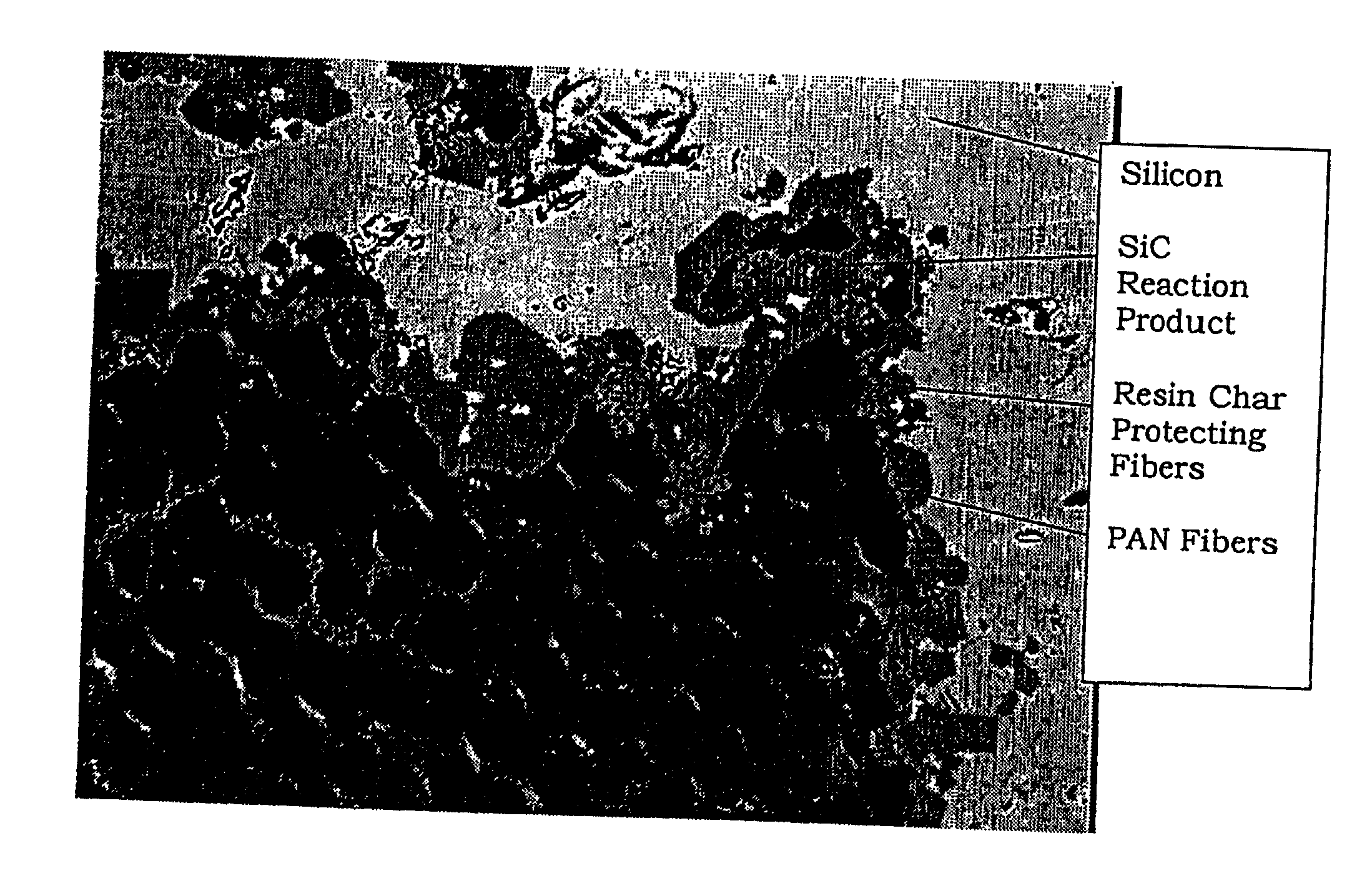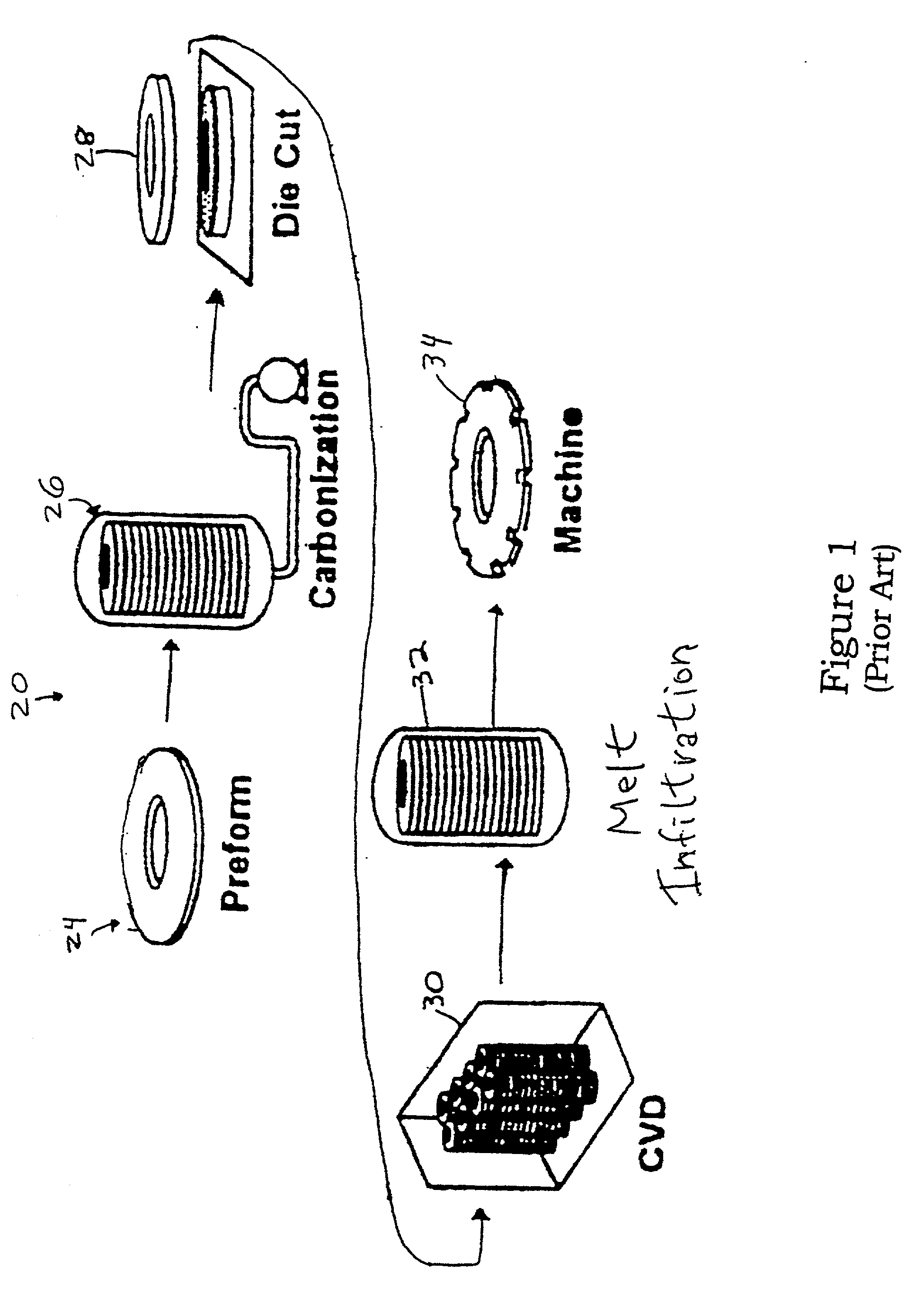Melt-infiltrated pitch-pan preforms
- Summary
- Abstract
- Description
- Claims
- Application Information
AI Technical Summary
Benefits of technology
Problems solved by technology
Method used
Image
Examples
example 1
[0029] 15V coal tar pitch and 2-furaldehyde (furfural) were mixed in a 50:50 weight-percent ratio. The mixture was heated to 70.degree. C. to dissolve the pitch in the furfural, forming a pitch resin mixture. The pitch resin mixture was allowed to cool to room temperature. Subsequently, a 656 gram fraction of the pitch resin mixture was warmed to 50.degree. C. and 66 grams of toluenesulfonic acid catalyst was dissolved into it. Separately, 720 grams of polyacrylonitrile (PAN) fibers (Fortafil grade 143) were dry blended with 126 grams of graphite powder (Lonza KS-44) in a plastic bag. The warm acidified pitch resin mixture was added to the PAN / graphite mixture in the bag and the components were blended together. The entire mixture was then charged into an 8".times.8".times.75" square press mold having a cavity shaped to provide a preform.
[0030] The mold was pressurized to 70 psi (to stops) and then clamped together with steel draw bolts to maintain pressure. The pressurized mold was...
example 2
[0034] 15V coal tar pitch and furfural were mixed in a 50:50 weight-percent ratio. The mixture was heated to 158.degree. F. (70.degree. C.) to dissolve the pitch in the furfural, forming a pitch resin mixture. The pitch resin mixture was allowed to cool to room temperature. Subsequently, a 400 gram fraction of the pitch resin mixture was warmed to 122.degree. F. (50.degree. C.) and 42 grams of toluenesulfonic acid catalyst was dissolved into it. The warm acidified pitch resin mixture was added to 500 grams of PAN fibers (Fortafil grade 143) in the bag and the components were blended together. The entire mixture was then charged into a 200 mm cylindrical die.
[0035] The die was placed in a heated platen press and heated to 302.degree. F. (150.degree. C.) for a period of 2 hours, during which time the pressure within the cavity of the die was maintained at 70 psi. The die and the disc preform which formed therein as a result of this procedure were then allowed to cool under 70 psi pres...
examples
Operating
[0039] Pad / rotor friction couples were tested on a Greening Test Labs Friction Assessment Screening Test (FAST) apparatus. The FAST apparatus rotates a 7" brake rotor at a sliding speed of 23 ft / sec. A 0.5".times.0.5" pad is pressed into the rotor to maintain constant predetermined torque. The apparatus displays the data as lining normal pressure / friction coefficient as a function of time. The test is run for 90 minutes. Measurements are taken of the pad to determine wear rate, which is expressed in horsepower per (cubic inch-hour).
[0040] Three rotors made from preforms of the present invention were tested with three different pads. Two of the pads consisted of
[0041] C / SiC where PAN fibers were also used, but the preform employed phenolic resin and CVD pyrocarbon to protect the fibers. One test was run with the fibers parallel to the disc surface and the other test was run with the fibers oriented normal to the disc surface. The third pad was made of the same preform materi...
PUM
| Property | Measurement | Unit |
|---|---|---|
| Time | aaaaa | aaaaa |
| Pressure | aaaaa | aaaaa |
| Angle | aaaaa | aaaaa |
Abstract
Description
Claims
Application Information
 Login to View More
Login to View More - R&D
- Intellectual Property
- Life Sciences
- Materials
- Tech Scout
- Unparalleled Data Quality
- Higher Quality Content
- 60% Fewer Hallucinations
Browse by: Latest US Patents, China's latest patents, Technical Efficacy Thesaurus, Application Domain, Technology Topic, Popular Technical Reports.
© 2025 PatSnap. All rights reserved.Legal|Privacy policy|Modern Slavery Act Transparency Statement|Sitemap|About US| Contact US: help@patsnap.com



